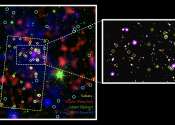Astronomers inspect two galactic open clusters
Using the Tubitak National Observatory (TUG) and ESA's Gaia satellite, Turkish astronomers have inspected Berkeley 68 and Stock 20—two galactic open clusters. Results of the study, presented November 17 on the arXiv pre-print ...









